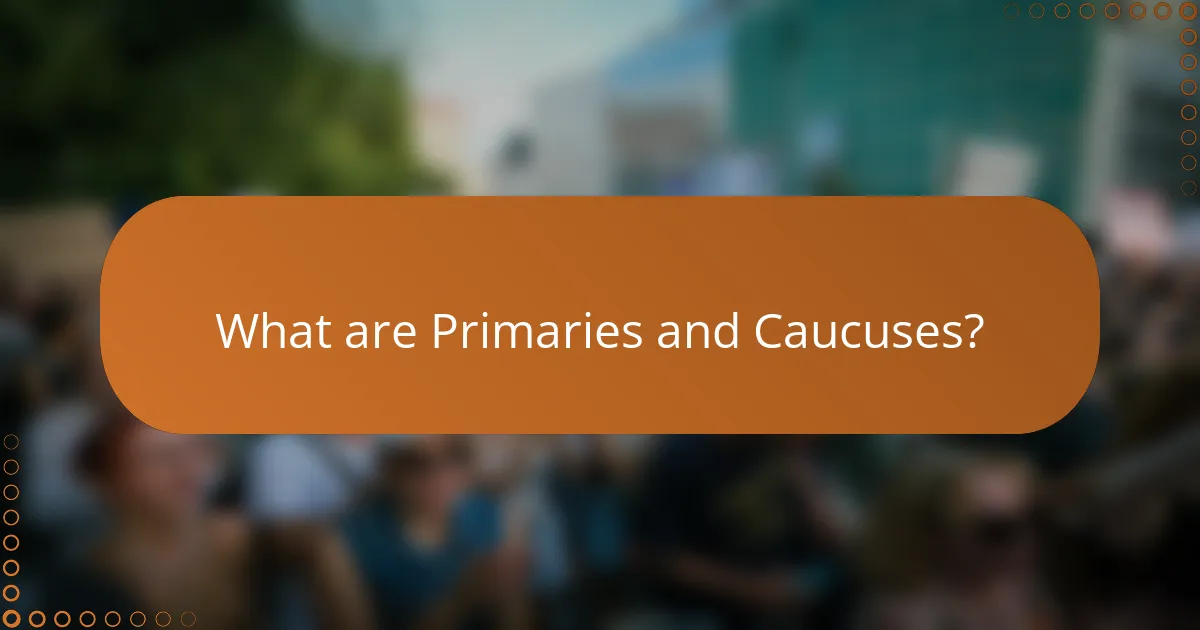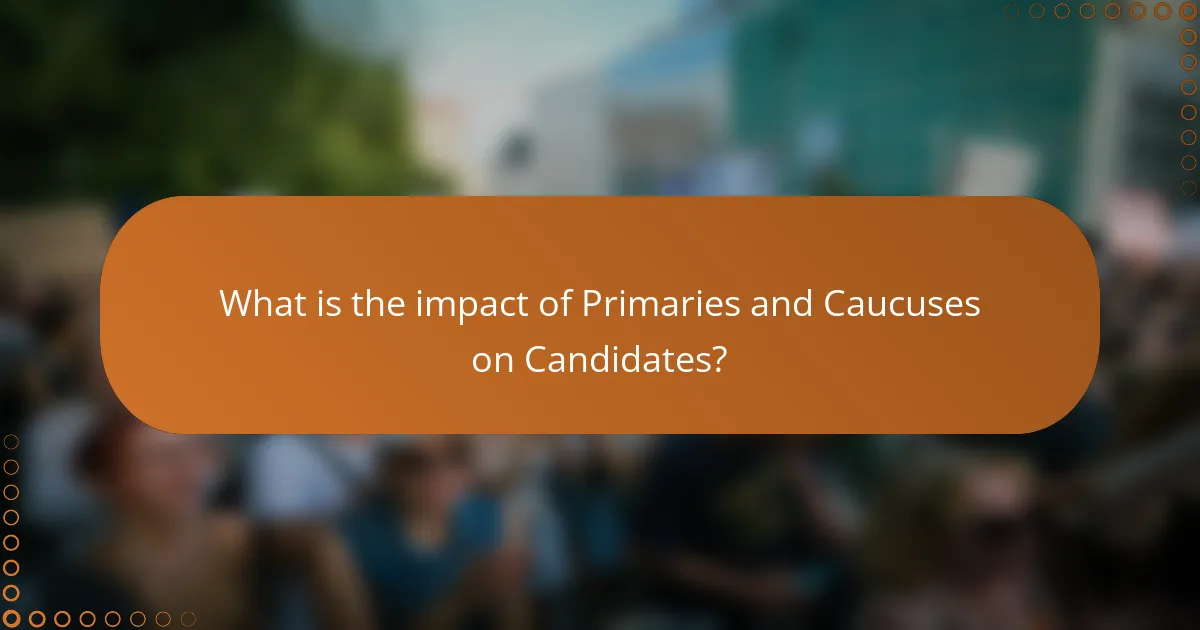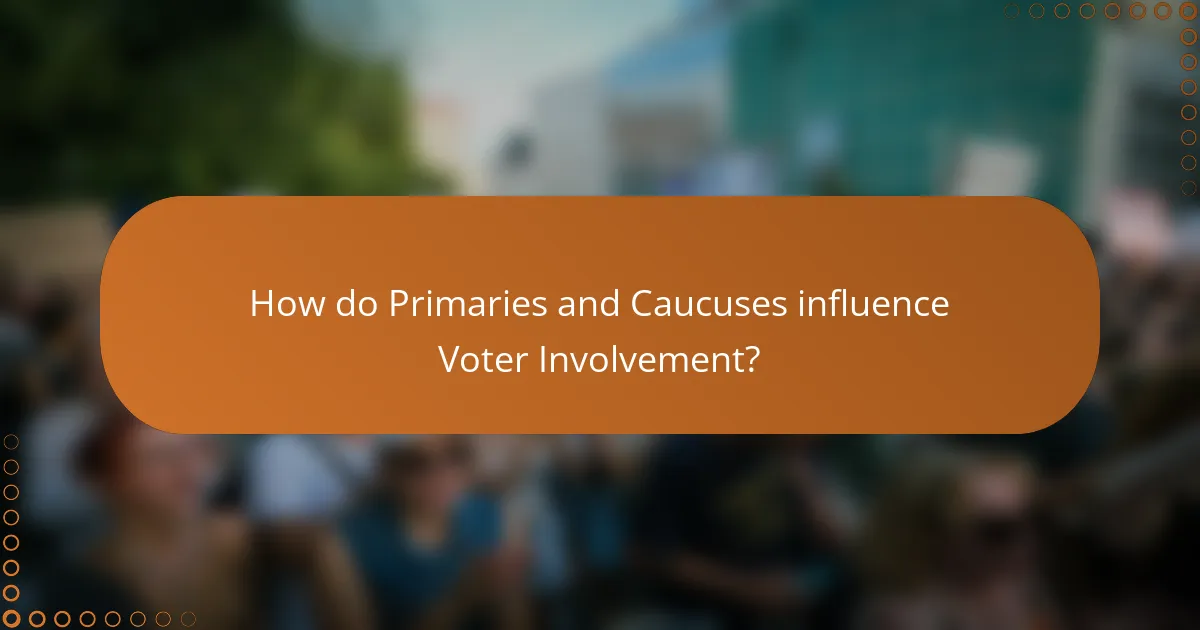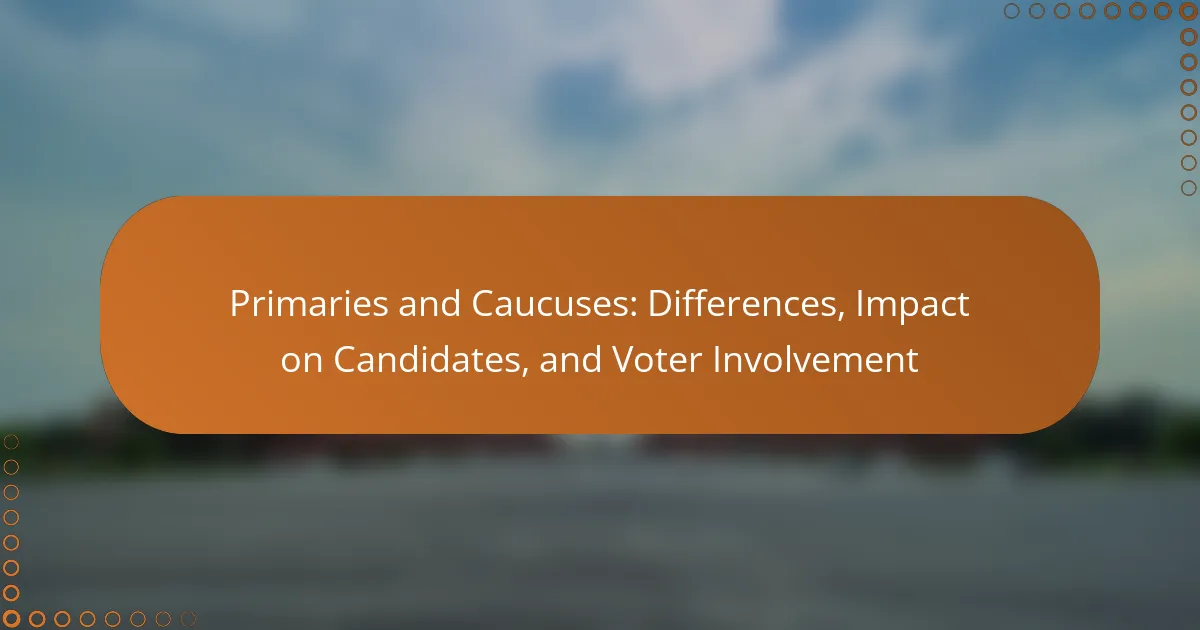Primaries and caucuses are essential electoral processes in the United States that determine a political party’s nominee for the presidential election. Primaries are state-level elections where party members vote for their preferred candidates, while caucuses involve local gatherings for discussion and consensus-building. These mechanisms significantly influence candidates’ viability, momentum, and strategies, as well as voter engagement and participation. Competitive primaries often lead to higher voter turnout, and caucuses can foster informed discussions among participants. Overall, primaries and caucuses play a crucial role in shaping the electoral landscape and mobilizing voters.

What are Primaries and Caucuses?
Primaries and caucuses are methods used in the United States to select a party’s nominee for the presidential election. Primaries are state-level elections where party members vote for their preferred candidate. These can be open, closed, or semi-closed, depending on state rules. Caucuses, on the other hand, are local gatherings where party members discuss and select candidates through discussion and consensus. They typically involve more direct interaction among participants. Both primaries and caucuses play a crucial role in shaping the candidate field before the national convention. In 2020, for example, over 60% of Democratic delegates were selected through primaries.
How do Primaries differ from Caucuses?
Primaries are state-level elections where voters cast ballots for their preferred candidates. Caucuses, on the other hand, are local gatherings where party members discuss and select candidates. In primaries, voting is typically done privately and resembles a general election format. Caucuses often involve open discussions and public voting, which can lead to a more communal decision-making process.
Primaries can be open, closed, or semi-closed, affecting who can vote. Caucuses usually require participants to be registered party members. The primary process generally allows for higher voter turnout compared to caucuses, which may have lower participation due to their time-consuming nature. Historical data shows that primaries have become more common than caucuses in recent years, with many states shifting to primary systems for their efficiency.
What are the key characteristics of Primaries?
Primaries are electoral processes used to select candidates for political office. They can be classified into two main types: open and closed primaries. Open primaries allow voters to choose candidates regardless of their registered party affiliation. Closed primaries require voters to be registered with a specific party to participate. Primaries can also be binding or non-binding. Binding primaries commit delegates to vote for a specific candidate at the party convention. Non-binding primaries do not require delegates to follow the primary results. Additionally, primaries can influence party platforms and candidate viability. They play a crucial role in shaping the electoral landscape and determining party nominees.
What are the key characteristics of Caucuses?
Caucuses are a method of selecting candidates for political office through local gatherings. They involve party members meeting to discuss and vote on their preferred candidates. Caucuses typically require participants to publicly express their choice, often through raising hands or forming groups. This process fosters direct engagement and debate among party members. Unlike primaries, caucuses can take several hours and may include speeches and discussions. They often result in lower voter turnout compared to primary elections. Historically, caucuses have been used in various states, with notable examples in Iowa and Nevada. The unique structure of caucuses can lead to more grassroots involvement and community discussion.
Why are Primaries and Caucuses important in the election process?
Primaries and caucuses are crucial in the election process because they determine the candidates who will run in the general election. These events allow political parties to gauge voter preferences and select their nominees. In the United States, primaries can be open or closed, affecting voter participation. Caucuses involve discussions and voting within local party meetings, promoting grassroots involvement. According to the National Association of Secretaries of State, over 20 states use caucuses, highlighting their significance. Primaries and caucuses also influence campaign strategies, as candidates tailor their messages to appeal to specific voter demographics. Ultimately, they play a vital role in shaping the electoral landscape and ensuring democratic representation.
How do they influence candidate selection?
Primaries and caucuses significantly influence candidate selection by determining which candidates advance in the electoral process. They provide a mechanism for party members to express their preferences for candidates. In primaries, voters cast secret ballots, while caucuses involve public discussion and voting. The outcomes of these events can shape public perception and momentum for candidates. For instance, winning early primaries often leads to increased media attention and fundraising opportunities. According to a study by the Pew Research Center, candidates who perform well in early states tend to receive a boost in national polls. This influence is crucial in narrowing the field of candidates and shaping the eventual nominee for the party.
What role do they play in party dynamics?
Primaries and caucuses play a crucial role in party dynamics by determining candidate nominations. They serve as a mechanism for party members to express their preferences for candidates. This process influences the selection of candidates who will represent the party in general elections. Primaries often lead to increased voter engagement and participation within the party. Caucuses can foster deeper discussions among party members about candidates and policies. The outcomes of these events can shape party platforms and strategies for the general election. Historical data shows that successful candidates often gain momentum and support from party leaders following strong performances in primaries and caucuses.

What is the impact of Primaries and Caucuses on Candidates?
Primaries and caucuses significantly impact candidates by determining their viability and momentum in elections. These processes serve as early indicators of public support. Candidates who perform well can gain media attention and attract more funding. Conversely, poor performance may lead to decreased support and campaign withdrawals. For example, in the 2008 Democratic primaries, Barack Obama’s success in Iowa boosted his campaign significantly. Primaries and caucuses also influence candidate strategies, as they must tailor their messages to appeal to specific voter demographics. Overall, these electoral processes are crucial in shaping the trajectory of candidates’ campaigns.
How do Primaries and Caucuses affect candidate strategies?
Primaries and caucuses significantly shape candidate strategies. Candidates tailor their approaches based on the type of primary or caucus. In states with open primaries, candidates appeal to a broader electorate, including independents. Conversely, in closed primaries, candidates focus on mobilizing their party’s base.
Caucuses require candidates to invest more time in grassroots organizing and face-to-face interactions. This is because caucus participants often engage in discussions and persuasion. In contrast, primaries can rely more on traditional campaigning methods, such as advertisements and rallies.
Candidates also analyze polling data from primaries and caucuses to adjust their messaging. Successful candidates often shift strategies based on early results to maintain momentum. Historical examples include Barack Obama in 2008, who adapted his campaign based on early primary outcomes.
Overall, the structure of primaries and caucuses influences candidate strategy decisions, voter outreach, and resource allocation.
What strategies do candidates use in Primaries?
Candidates use various strategies in primaries to secure their party’s nomination. They often focus on grassroots campaigning to connect with voters directly. This involves door-to-door canvassing and attending local events. Candidates also utilize targeted advertising to reach specific demographics. They analyze voter data to tailor their messages effectively. Fundraising is crucial; candidates cultivate donors to support their campaigns. Endorsements from influential figures can enhance credibility and visibility. Debates and public appearances help candidates showcase their policies and personality. Additionally, candidates may form alliances with local organizations to strengthen their outreach.
What strategies do candidates use in Caucuses?
Candidates use several strategies in caucuses to secure delegate support. They often focus on grassroots organizing to mobilize local supporters. Engaging in face-to-face interactions is crucial in caucus settings. Candidates also employ persuasion techniques to sway undecided participants. They may align with local party leaders to gain credibility. Building coalitions with like-minded candidates can enhance their chances. Campaigning in key precincts is a common tactic to maximize influence. Additionally, candidates tailor their messages to resonate with specific voter concerns. These strategies are essential for navigating the unique dynamics of caucus events.
What are the advantages and disadvantages for candidates in each system?
Primaries and caucuses present distinct advantages and disadvantages for candidates. In primaries, candidates benefit from a larger voter turnout, which can enhance visibility and support. This system allows for a straightforward voting process, making it easier for candidates to gauge public opinion. However, primaries can also lead to a more expensive campaign due to widespread advertising and outreach efforts.
In contrast, caucuses offer candidates a more intimate setting for discussions and can foster stronger personal connections with party members. This can lead to dedicated grassroots support. Nevertheless, caucuses often have lower participation rates, which may limit candidate exposure. Additionally, the complexity of the caucus process can hinder voter understanding and participation, potentially disadvantaging candidates who rely on broader appeal.
What advantages do Primaries offer candidates?
Primaries offer candidates several advantages, including increased visibility and voter engagement. Candidates can showcase their platforms and connect with potential supporters. Primaries also help candidates gauge public support and adjust their strategies accordingly. Additionally, winning a primary can enhance a candidate’s credibility and momentum heading into the general election. Historical data shows that candidates who perform well in primaries often secure more funding and endorsements. For instance, the 2020 Democratic primary highlighted how early victories boosted candidates’ national profiles. Overall, primaries play a crucial role in shaping a candidate’s campaign trajectory.
What disadvantages do Caucuses present for candidates?
Caucuses present several disadvantages for candidates. They require significant time and effort from participants. This can lead to lower overall turnout compared to primaries. Candidates may struggle to mobilize supporters effectively. The public nature of caucus voting can discourage some individuals from participating. Candidates may also face challenges in securing delegate support due to complex rules. Additionally, caucuses can favor candidates with strong grassroots organizations. This often disadvantages those with less established networks. Overall, these factors can hinder a candidate’s ability to compete successfully.

How do Primaries and Caucuses influence Voter Involvement?
Primaries and caucuses significantly influence voter involvement by shaping the electoral process. They determine which candidates appear on the general election ballot. This selection process engages voters early in the election cycle. Increased competition among candidates encourages voter participation. For instance, states with competitive primaries often see higher turnout rates. According to the U.S. Census Bureau, primary turnout can exceed 30% in highly contested races. In contrast, caucuses may foster deeper discussions among participants, enhancing civic engagement. The format of caucuses can lead to a more informed electorate. Overall, both mechanisms mobilize voters and stimulate interest in the electoral process.
What factors affect voter turnout in Primaries and Caucuses?
Voter turnout in primaries and caucuses is influenced by several factors. These include the competitiveness of the race, which can motivate voters to participate. High-profile candidates tend to draw more interest and increase turnout. Additionally, the method of voting affects participation; states with easier access to early voting or mail-in ballots generally see higher turnout. Voter registration processes also play a critical role; streamlined registration can boost participation. Furthermore, demographic factors such as age, education, and socioeconomic status impact turnout rates. Historical data shows that states with closed primaries often have lower turnout compared to open primaries.
How does the timing of Primaries and Caucuses impact voter turnout?
The timing of primaries and caucuses significantly impacts voter turnout. Early primaries tend to generate higher engagement. Voters are more motivated to participate when races are competitive and outcomes are uncertain. For example, the New Hampshire primary often sees increased turnout due to its early scheduling and media attention. Conversely, later primaries may experience lower turnout as the outcome becomes clearer. A study by the Pew Research Center found that states holding their primaries earlier in the election cycle typically see a 10-15% increase in voter participation compared to those held later. Thus, timing plays a crucial role in shaping voter enthusiasm and turnout levels.
What demographic trends are observed in voter participation?
Voter participation shows significant demographic trends influenced by age, race, and education. Younger voters, particularly those aged 18-29, tend to have lower turnout rates compared to older age groups. In the 2020 U.S. presidential election, approximately 50% of eligible voters aged 18-29 participated, while about 72% of those aged 65 and older voted. Racial and ethnic minorities, such as African American and Hispanic voters, have increased their participation rates over recent elections. For instance, Black voter turnout rose to 61% in 2020, up from 55% in 2016. Educational attainment also impacts voter participation; individuals with college degrees are more likely to vote than those without. In 2020, around 78% of college-educated voters cast their ballots, compared to 54% of those with only a high school diploma. These trends illustrate how demographics shape voter engagement in elections.
How can voter engagement be increased in Primaries and Caucuses?
Voter engagement in primaries and caucuses can be increased through targeted outreach and education initiatives. Informing voters about the importance of participating in these events fosters a sense of civic duty. Utilizing social media campaigns can effectively reach younger demographics, who may be less engaged. Hosting community events and forums allows for direct interaction between candidates and voters. Additionally, simplifying the registration process encourages participation. Research indicates that states with automatic voter registration see higher engagement rates. Providing clear information on voting procedures can alleviate confusion and increase turnout.
What initiatives have proven effective in boosting voter turnout?
Mail-in voting initiatives have proven effective in boosting voter turnout. Studies show that states offering mail-in ballots see higher participation rates. For example, Oregon, which implemented universal mail-in voting, reported a turnout increase of over 10% in the 2016 presidential election. Additionally, same-day registration has also been linked to increased voter engagement. Research indicates that states allowing same-day registration experienced a turnout boost of 7% on average. These initiatives make voting more accessible and convenient, contributing to higher overall participation in elections.
How can technology be leveraged to enhance voter involvement?
Technology can enhance voter involvement by providing accessible platforms for education and engagement. Online voting systems can simplify the voting process, allowing more people to participate. Mobile apps can offer real-time information about candidates and issues. Social media campaigns can raise awareness and encourage discussions among voters. Data analytics can target specific demographics to increase outreach efforts. Virtual town halls can facilitate direct communication between candidates and voters. Research shows that states using online voter registration saw increased participation rates. For example, California reported a 20% increase in registered voters after implementing online registration.
Primaries and caucuses are essential electoral processes in the United States that determine party nominees for presidential elections. This article outlines the differences between primaries and caucuses, including their formats, voter participation, and impact on candidate strategies. It examines the characteristics of each system, their advantages and disadvantages for candidates, and how they influence voter involvement and turnout. Additionally, the article explores demographic trends in voter participation and highlights effective initiatives and technological advancements to enhance engagement in these critical electoral events.
